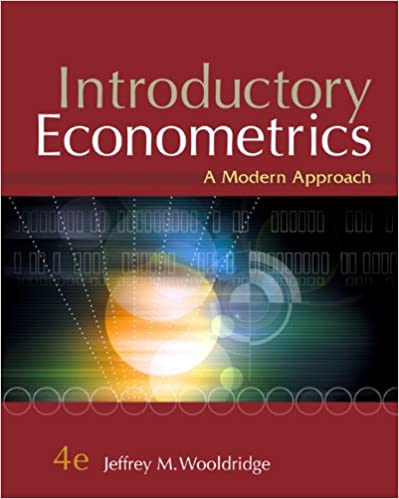
Introductory Econometrics 4th Edition by Jeffrey Wooldridge
Edition 4ISBN: 978-0324660609
Introductory Econometrics 4th Edition by Jeffrey Wooldridge
Edition 4ISBN: 978-0324660609 Exercise 8
You are hired by the governor to study whether a tax on liquor has decreased average liquor consumption in your state. You are able to obtain, for a sample of individuals selected at random, the difference in liquor consumption (in ounces) for the years before and after the tax. For person i who is sampled randomly from the population, Yi denotes the change in liquor consumption. Treat these as a random sample from a Normal ( , 2 ) distribution.
(i) The null hypothesis is that there was no change in average liquor consumption. State this formally in terms of .
(ii) The alternative is that there was a decline in liquor consumption; state the alternative in terms of .
(iii) Now, suppose your sample size is n = 900 and you obtain the estimates =-32.8 and s = 466.4. Calculate the t statistic for testing H 0 against H 1 ; obtain the p-value for the test. (Because of the large sample size, just use the standard normal distribution tabulated in Table G.1.) Do you reject H 0 at the 5% level At the 1% level
=-32.8 and s = 466.4. Calculate the t statistic for testing H 0 against H 1 ; obtain the p-value for the test. (Because of the large sample size, just use the standard normal distribution tabulated in Table G.1.) Do you reject H 0 at the 5% level At the 1% level
(iv) Would you say that the estimated fall in consumption is large in magnitude Comment on the practical versus statistical significance of this estimate.
(v) What has been implicitly assumed in your analysis about other determinants of liquor consumption over the two-year period in order to infer causality from the tax change to liquor consumption
(i) The null hypothesis is that there was no change in average liquor consumption. State this formally in terms of .
(ii) The alternative is that there was a decline in liquor consumption; state the alternative in terms of .
(iii) Now, suppose your sample size is n = 900 and you obtain the estimates
 =-32.8 and s = 466.4. Calculate the t statistic for testing H 0 against H 1 ; obtain the p-value for the test. (Because of the large sample size, just use the standard normal distribution tabulated in Table G.1.) Do you reject H 0 at the 5% level At the 1% level
=-32.8 and s = 466.4. Calculate the t statistic for testing H 0 against H 1 ; obtain the p-value for the test. (Because of the large sample size, just use the standard normal distribution tabulated in Table G.1.) Do you reject H 0 at the 5% level At the 1% level (iv) Would you say that the estimated fall in consumption is large in magnitude Comment on the practical versus statistical significance of this estimate.
(v) What has been implicitly assumed in your analysis about other determinants of liquor consumption over the two-year period in order to infer causality from the tax change to liquor consumption
Explanation
Y i is a random variable that denotes ch...
Introductory Econometrics 4th Edition by Jeffrey Wooldridge
Why don’t you like this exercise?
Other Minimum 8 character and maximum 255 character
Character 255


